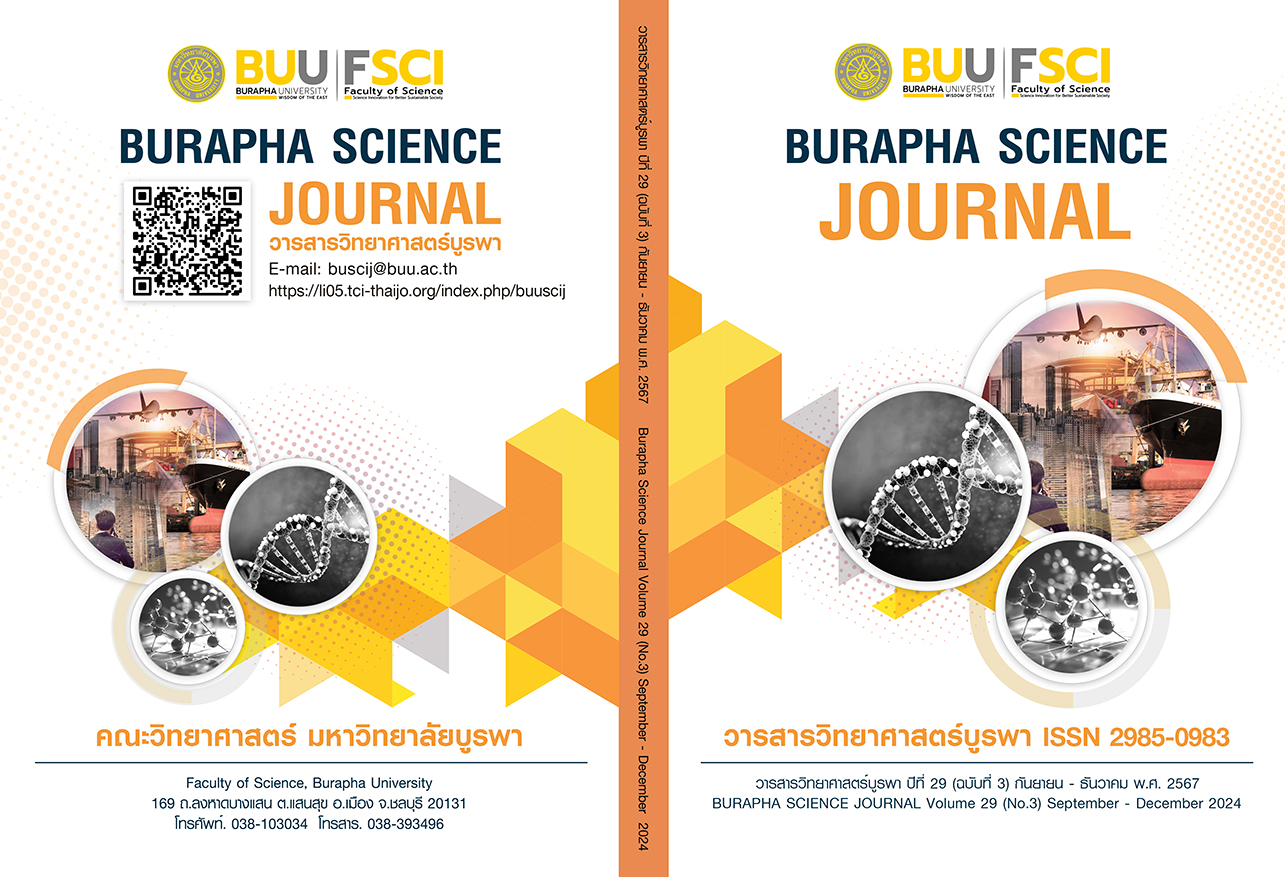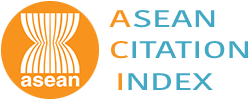การเปรียบเทียบประสิทธิภาพของระบบเติมอากาศแบบไมโครนาโนบับเบิ้ล (รุ่น Chan Shrimp Model I) กับระบบเติมอากาศแบบจานจ่ายอากาศ และแบบแอร์ลิฟท์ ในบ่อเลี้ยงปลานิลแดงแบบหนาแน่นในโรงเรือน
คำสำคัญ:
ระบบเติมอากาศ , จานจ่ายอากาศ, แอร์ลิฟท์ , ไมโครนาโนบับเบิ้ล , ปลานิลแดงบทคัดย่อ
วัตถุประสงค์และที่มา : ปัจจุบันการเลี้ยงปลานิลแดงนิยมเลี้ยงแบบหนาแน่นในโรงเรือน จำเป็นต้องใช้ระบบเติมอากาศเพื่อเพิ่มออกซิเจนที่ละลายน้ำให้อยู่ในระดับที่เหมาะสมต่อการเจริญเติบโตของปลา ดังนั้นวัตถุประสงค์ของการศึกษา ครั้งนี้คือ การเปรียบเทียบประสิทธิภาพระบบเติมอากาศแบบไมโครนาโนบับเบิ้ลรุ่น Chan shrimp model I กับระบบเติมอากาศแบบจานจ่ายอากาศ และ แอร์ลิฟท์ ทั้งในสภาวะมาตรฐานและในบ่อเลี้ยงปลานิลแดงแบบหนาแน่นในโรงเรือน
วิธีดำเนินการวิจัย : วางแผนการทดลองแบบสุ่มบล็อกสมบูรณ์ (randomized complete block design) ประกอบด้วย 3 ชุดการทดลองได้แก่ ชุดการทดลองที่ 1 ระบบเติมอากาศแบบจานจ่ายอากาศ ชุดการทดลองที่ 2 ระบบเติมอากาศแบบแอร์ลิฟท์ และชุดการทดลองที่ 3 ระบบเติมอากาศแบบไมโครนาโนบับเบิ้ลที่มีความเข้มข้นของออกซิเจนในอากาศ 99 เปอร์เซ็นต์ กำหนดให้บล็อกคือรอบของการทดลองหรือวันที่ทดลอง การทดลองได้ดำเนินการชุดการทดลองละ 3 ซ้ำ (3 วัน) โดยทดลองในบ่อผ้าใบทรงกลม 3 บ่อ ขนาดเส้นผ่าศูนย์กลาง 3 เมตร เติมน้ำลึก 70 เซนติเมตร ปริมาตรน้ำ 4.95 ลูกบาศก์เมตร ทำการทดลองเพื่อทดสอบประสิทธิภาพของระบบเติมอากาศภายใต้สองสภาวะ ได้แก่ สภาวะมาตรฐาน ซึ่งใช้น้ำสะอาด (น้ำประปา) และในน้ำจากบ่อเลี้ยงปลานิลแดง รวมทั้งทดสอบในบ่อเลี้ยงปลานิลแดงที่ปล่อยปลานิลแดงที่มีน้ำหนักเฉลี่ย(+SD) อยู่ในช่วง 244.92±0.21 - 245.46±0.15 กรัม และความยาวเฉลี่ย(+SD) อยู่ในช่วง 21.16±0.42 - 21.27±0.23 เซนติเมตร จำนวน 500 ตัว/บ่อ ซึ่งมีอัตราความหนาแน่นเท่ากับ 70.77 ตัว/ตารางเมตร หรือ 24.74±0.02 - 24.81±0.03 กิโลกรัม/ลูกบาศก์เมตร เก็บข้อมูลการเปลี่ยนแปลงอุณหภูมิน้ำและออกซิเจนที่ละลายในน้ำจนถึงจุดอิ่มตัวเพื่อนำข้อมูลที่ได้ไปคำนวณหาประสิทธิภาพของระบบเติมอากาศ รวมทั้งข้อมูลต้นทุนของระบบเติมอากาศ และข้อมูลต้นทุนค่าไฟฟ้า
ผลการวิจัย : พบว่าในน้ำสะอาด ค่ามาตรฐานอัตราการถ่ายเทออกซิเจน (SOTR; kgO2.hr-1) และค่าประสิทธิภาพมาตรฐานการให้อากาศ (SAE; kgO2.kW-1.hr-1) ของระบบเติมอากาศแบบไมโครนาโนบับเบิ้ล มีประสิทธิภาพดีที่สุด และมีความแตกต่างอย่างมีนัยสำคัญทางสถิติ (p<0.05) รองลงมา คือ ระบบเติมอากาศแบบแอร์ลิฟท์ และจานจ่ายอากาศตามลำดับ เช่นเดียวกันกับ ในน้ำจากบ่อเลี้ยงปลา พบว่า ค่ามาตรฐานอัตราการถ่ายเทออกซิเจน (SOTR; kgO2.hr-1) และค่าประสิทธิภาพมาตรฐานการให้อากาศ (SAE; kgO2.kW-1.hr-1) ของระบบเติมอากาศแบบไมโครนาโนบับเบิ้ล มีประสิทธิภาพดีที่สุด และมีความแตกต่างอย่างมีนัยสำคัญทางสถิติ (p<0.05) รองลงมา คือ ระบบเติมอากาศแบบแอร์ลิฟท์ และจานจ่ายอากาศ ตามลำดับ ระบบเติมอากาศแบบไมโครนาโนบับเบิ้ลมีเปอร์เซ็นต์ต้นทุนรวม(+SD) ของระบบเติมอากาศต่ำที่สุด (28.69±3.81เปอร์เซ็นต์ ) มีความแตกต่างอย่างมีนัยสำคัญทางสถิติ (p<0.05) เมื่อเทียบกับระบบเติมอากาศแบบแอร์ลิฟท์และแบบจานจ่ายอากาศ นอกจากนี้ระบบเติมอากาศแบบไมโครนาโนบับเบิ้ลสามารถลดต้นทุน (+SD) ได้สูงสุด (71.31±3.81 เปอร์เซ็นต์) รองลงมาคือระบบเติมอากาศแบบแอร์ลิฟท์ และจานจ่ายอากาศ ตามลำดับ ส่วนผลการทดสอบประสิทธิภาพของเครื่องเติมอากาศในบ่อเลี้ยงปลานิลแดงพบว่า อัตราการถ่ายเทออกซิเจนในสภาพการเลี้ยงจริง (OTRf; kgO2.hr-1) ค่าประสิทธิภาพของเครื่องเติมอากาศ (AEf; kgO2.kW-1.hr-1) ค่าความต้องการพลังงานทั้งหมดที่ใช้ในการเปิดระบบเติมอากาศของบ่อเลี้ยงสัตว์น้ำ (PR; W) ของระบบเติมอากาศไมโครนาโนบับเบิ้ลมีประสิทธิภาพสูงกว่าและมีความแตกต่างอย่างมีนัยสำคัญทางสถิติ (p<0.05) เมื่อเปรียบเทียบกับระบบเติมอากาศแบบแอร์ลิฟท์ และจานจ่ายอากาศ ตามลำดับ
สรุปผลการวิจัย : ระบบเติมอากาศแบบไมโครนาโนบับเบิ้ลรุ่น Chan Shrimp Model I มีประสิทธิภาพในการเติมออกซิเจนลงในน้ำดีที่สุด สามารถลดต้นทุน(+SD) ด้านพลังงานสูงถึง 57.09±1.41 เปอร์เซ็นต์และ 14.22±2.40 เปอร์เซ็นต์เมื่อเทียบกับระบบเติมอากาศแบบจานจ่าย และระบบเติมอากาศแบบแอร์ลิฟท์ ตามลำดับ
เอกสารอ้างอิง
Abdel-Tawwab, M., Hagras, A. E., Elbaghdady, H. A. M., & Monier, M. N. (2015). Effects of dissolved oxygen and fish size on Nile tilapia, Oreochromis niloticus (L.): growth performance, whole-body composition, and innate immunity. Aquaculture International, 23, 1261-1274. DOI: https://doi.org/10.1007/s10499-015-9882-y.
Ali, S. A., Raju, H. M., & Kassab, G. (2023). Seasonal species diversity and dominance of phytoplankton in different types of tropical domestic sewage oxidation ponds. Ecology, Environment and Conservation. DOI: 10.53550/EEC.2023.v29i01s.0515.
Bahri, S., & Anwar, H. (2019, June). The ineffectiveness of water splash on paddlewheel aerator. In IOP Conference Series: Earth and Environmental Science (Vol. 268, No. 1, p. 012162). IOP Publishing. DOI: 10.1088/1755-1315/268/1/012162.
Barrut, B., Blancheton, J. P., Champagne, J. Y., & Grasmick, A. (2012). Mass transfer efficiency of a vacuum airlift application to water recycling in aquaculture systems. Aquacultural Engineering, 46, 18-26. DOI: 10.1016/j.aquaeng.2011.10.004
Boyd, C. E., & Moore, J. M. (1993). Factors affecting the performance of diffused-air aeration systems for aquaculture. Journal of Applied Aquaculture, 2 (2), 1–12. DOI: 10.1300/J028v02n02_01.
Boyd, C. E., (1998). Pond water aeration systems. Aquacultural engineering, 18 (1), 9-40. DOI: https://doi.org/10.1016/S0144-8609(98)00019-3
Boyd, C. E. (2019). Water quality: An introduction. 2nd ed., Springer International Publishing. New York. 357 pp. DOI: 10.1007/978-3-319-17446-4.
Dayıoğlu, M. A., (2022). Experimental study on design and operational performance of solar-powered venturi aeration system developed for aquaculture–A semi-floating prototype. Aquacultural Engineering, 98, 102255. DOI: 10.1016/j.aquaeng.2022.102255.
Green, B. W., Rawles, S. D., Ray, C. L. & McEntire, M. E. (2024). Relationship between stocking rate and production of stocker hybrid tilapia and water quality in a mixtotrophic biofloc system. Journal of The World Aquaculture Society, 55 (5) e13087. DOI: 10.1111/jwas.13087.
Khan, P., Zhu, W., Huang, F., Gao, W., & Khan, N. A. (2020). Micro–nanobubble technology and water-related application. Water Supply, 20(6), 2021-2035. DOI: 10.2166/ws.2020.121.
Kumar, A., Moulick, S., & Mal, B. C. (2013). Selection of aerators for intensive aquacultural pond. Aquacultural engineering, 56, 71-78. DOI: https://doi.org/10.1016/j.aquaeng.2013.05.003.
Levitsky, I., Tavor, D., & Gitis, V. (2022). Micro and nanobubbles in water and wastewater treatment: A state- of-the-art review. Journal of Water Process Engineering, 47, 102688. DOI: https://doi.org/10.1016/j.jwpe.2022.102688.
Loyless, J. C., & Malone, R. F. (1998). Evaluation of air-lift pump capabilities for water delivery, aeration,and degasification for application to recirculating aquaculture systems. Aquacultural engineering, 18 (2), 117-133. DOI: 10.1016/S0144-8609(98)00025-9.
Mahasri, G., Saskia, A., Apandi, P.S., Dewi, N.N. Rozi & Usuman. N.M. (2018). Development of an aquaculture system using nanobubble technology for the optimation of dissolved oxygen in culture media for nile tilapia (Oreochromis niloticus). IOP Conf. Series: Earth and Environmental Science, 137 (1), 012046. DOI: 10.1088/1755-1315/137/1/012046.
Navisa, J., Sravya, T., Swetha, M., & Venkatesan, M. (2014). Effect of bubble size on aeration process. Asian Journal of Scientific Research, 7 (4), 482. DOI: 10.3923/ajsr.2014.482.487.
Nugroho, K. C., Rizky, P. N., Harijono, T., Halim, A. M., Nasuki, L., & Ritonga, BR. (2024). Comparative study of growth performance of three Tilapia strain in intensive culture system. IOP Conf. Series: Earth and Environmental Science, 1328, 012011. DOI: 10.1088/1755-1315/1328/1/012011.
Park, S. H., Batchelor, B., & Ghosh, A. (2022). Gas transfer model for a multistage vortex aerator: A novel oxygen transfer system for dissolved oxygen improvement. Journal of Environmental Management, 319, 115704. DOI: https://doi.org/10.1016/j.jenvman.2022.115704.
Pelster, B., Wood., C. M., Speers-Roesch, B., Driedzic, W. R., Almeida-Val, V., & Val, A. (2015). Gut transport characteristics in herbivorous and carnivorous serrasalmid fish from ion-poor Rio Negro water. Journal of Comparative Physiology B, 185, 225-241. DOI: 10.1007/s00360-014-0879-z.
Roy, S. M., P., J., Machavaram, R., Pareek, C. M., & Mal, B. C. (2021). Diversified aeration facilities for effective aquaculture systems-a comprehensive review. Aquaculture International, 29, 1181-1217.
DOI: https://doi.org/10.1007/s10499-021-00685-7. ·
Roy, S. M., Machavaram, R., Moulick, S., & Mukherjee, C. K. (2022). Economic feasibility study of aerators in aquaculture using life cycle costing (LCC) approach. Journal of Environmental Management, 302, 114037. DOI: 10.1016/j.jenvman.2021.114037. DOI: https://doi.org/10.1007/s10499-021-00685-7.
Sampantamit, T., Ho, L., Lachat, C., Sutummawong, N., Sorgeloos, P., & Goethals, P. (2020). Aquaculture production and its environmental sustainability in Thailand: Challenges and potential solutions. Sustainability, 12(5), 2010. DOI: https://doi.org/10.3390/su12052010.
Taukhid, I., Trijuno, D. D., Karim, M. Y., Syah, R., & Makmur, M. (2021). Effect of power pump and nozzle diameter microbubble generator to increase oxygen concentration in aquaculture. The Israeli Journal of Aquaculture-Bamidgeh, 73, 1547608. DOI: https://doi.org/10.46989/001c.31093.
Tekile, A., Kim, I., & Lee, J. Y. (2016). Extent and persistence of dissolved oxygen enhancement using nanobubbles. Environmental Engineering Research, 21(4), 427-435. DOI: https://doi.org/10.4491/eer.2016.028.
Wu, M., Yuan, S., Song, H., & Li, X. (2022). Micro-nano bubbles production using a swirling-type venturi bubble generator. Chemical Engineering and Processing-Process Intensification, 170, 108697. DOI: 10.1016/j.cep.2021.108697.
Yaparatne, S., Morón-López, J., Bouchard, D., B., Garcia-Segura, S., & Apul, O. G. (2024). Nanobubble applications in aquaculture industry for improving harvest yield, wastewater treatment, and disease control. Science of The Total Environment, 172687-172687. DOI: 10.1016/j.scitotenv.2024.172687.
Zhang, R., Sun, H., Kamthunzi, W. M., Collar, C. A., & Mitloehner, F. M. (2007). Aerator performance for wastewater lagoon application. In International Symposium on Air Quality and Waste Management for Agriculture, 16-19 September 2007, Broomfield, Colorado (p. 13). American Society of Agricultural and Biological Engineers. DOI: 10.13031/2013.23832.
Zhao, S., He, W., He, P., & Li, K. (2022). Comparison of planktonic bacterial communities indoor and outdoor of aquaculture greenhouses. Journal of Applied Microbiology, 132(4), 2605-2612. DOI: 10.1111/jam.15414.
ดาวน์โหลด
เผยแพร่แล้ว
รูปแบบการอ้างอิง
ฉบับ
ประเภทบทความ
สัญญาอนุญาต
ลิขสิทธิ์ (c) 2024 คณะวิทยาศาสตร์ มหาวิทยาลัยบูรพา

อนุญาตภายใต้เงื่อนไข Creative Commons Attribution-NonCommercial-NoDerivatives 4.0 International License.
Burapha Science Journal is licensed under a Creative Commons Attribution-NonCommercial-NoDerivatives 4.0 International (CC BY-NC-ND 4.0) licence, unless otherwise stated. Please read our Policies page for more information



